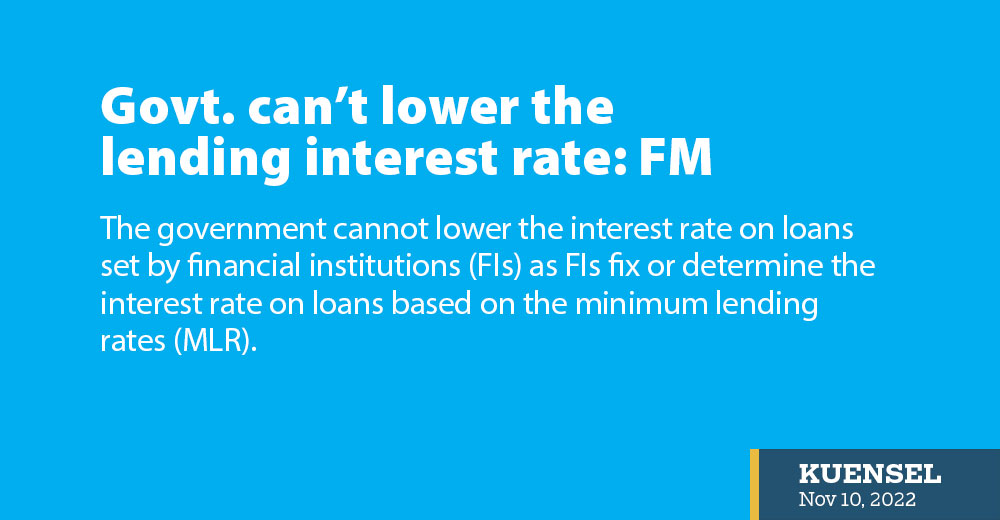Thukten Zangpo
The government cannot lower the interest rate on loans set by financial institutions (FIs) as FIs fix or determine the interest rate on loans based on the minimum lending rates (MLR).
Responding to questions on the high lending rates, the finance minister, Namgay Tshering reported to the National Assembly that the Royal Monetary Authority (RMA) has no authority in terms of fixing the interest rate on loans and is continuously reviewing the lending rates of the FIs based on the evolving nature of the economy.
The RMA revised the single MLR from 7.16 percent in December 2021 to 6.92 percent in June this year. A single MLR is computed by averaging the MLR of individual banks.
Lyonpo said that the FIs calculate the interest rate of loans based on the MLR and FIs also decide whether to fix above the MLR.
Lending rates differ from banks to banks. The Bhutan Development Bank Limited’s minimum lending rate is at 7 percent annually, and Bank of Bhutan Limited at 6.5 percent. Lyonpo said that the MLR is determined on FI’s marginal cost of funds, operational cost, and cost on the probable profit from cash reserve ratio (CRR).
He added that the FIs have to look into the funding source from fixed deposit and current deposit, interest rates on saving deposit and current deposit and operational costs. He said that Bhutan’s interest rate is not comparable with other countries because of the country’s small loans outstanding of Nu 165B from six FIs and limited FIs capital adequacy.
The finance ministry, the minister said, is in discussion with FIs to have differentiated interest rates for loans depending upon the economy of the country.
The current situation demands low interest loans to enhance local industries, which can substitute imports and save foreign currency reserves, Lyonpo said. However, he added that the construction and vehicle loans are not essential as of now.
On equated value of collaterals, Lyonpo said the government has come up with the revised property assessment and valuation agency’s (PAVA) rate. The PAVA rate is the basis for compensating for urban or rural land acquired by the government for public works.
Lyonpo said that the earlier PAVA rate was able to get only 40 percent of the market value, however, the revised rate will get land value near to 90 percent of the market value. With the revised rate, he said that the rural and urban land as collateral would get higher loans.
Bartsham-Shongphu MP, Passang Dorji said that RMA has the authority and responsibility to decide on the interest rate through tools like CRR, statutory liquidity ratio, and capital adequacy ratio.
He added that the RMA lowered CRR from 10 percent to 7 percent and there is a possibility for lowering the interest rate.
Opposition Leader Dorji Wangdi also said that banks used to charge higher interest rates earlier at 13 percent to 15 percent but later reduced to 7 to 12 percent.
Sharing what is practiced in the other countries, Dorji Wangdi said that the countries also follow the quantitative easing policy, where the lending rate is at zero percent.
He also said that start-ups entrepreneurs are facing difficulty in getting the bridge loans after they have established their businesses.
Drametse-Ngatsang MP Ugyen Wangdi asked if the interest rate could be revised to 5 percent from 6.5 percent.
Lyonpo said that when providing loans, the biggest problem is the loan appraisal system, whether the loans are diverted in the proposed activity.
He added that the National Cottage and Small Industry Bank provided loans at an interest rate of 5 percent and 2 percent. Most of the defaulters who borrowed at are those who borrowed at 2 percent.
Lyonpo also said that the then Bhutan Opportunity and Information Centre or Rural Enterprise Development Corporation limited in 2018 had an NPL ratio of 48 percent, and Bhutan Development Bank Limited at 21 percent.
To stock up the essential items, Lyonpo said that Nu 4.5B worth of bridging loan at 5 percent was provided during the pandemic and the government is aware of the repayment issue.
He said that the government discussed with the central and FIs for loan deferment and to convert the overdraft facility to term loans, as monetary measures.


